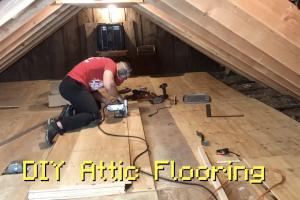Ultimate Guide: How to Floor an Attic for Maximum Use

-
Quick Links:
- Introduction
- Planning Your Attic Flooring
- Materials You'll Need
- Step-by-Step Guide to Flooring an Attic
- Insulation and Ventilation Considerations
- Safety Tips and Best Practices
- Case Studies and Expert Insights
- Cost Analysis
- Conclusion
- FAQs
Introduction
Flooring an attic can transform an underutilized space into a valuable area for storage, a playroom, or even a cozy office. This comprehensive guide will walk you through the entire process of flooring your attic—from planning and materials to installation and safety considerations.
Planning Your Attic Flooring
Before embarking on your attic flooring project, it’s crucial to plan effectively. Consider the following steps:
- Assess the Space: Measure the dimensions of your attic and check the height of the rafters.
- Purpose: Decide what you plan to use the space for—storage, living area, etc.
- Load-Bearing Capacity: Ensure the existing structure can support the additional weight of the flooring.
Materials You'll Need
Here’s a list of materials you might consider for flooring your attic:
- Plywood sheets
- Insulation material (if needed)
- Vapor barrier
- Construction adhesive
- Fasteners (screws/nails)
- Safety gear (gloves, goggles, mask)
Step-by-Step Guide to Flooring an Attic
Now, let's dive into the detailed steps for flooring your attic:
Step 1: Prepare the Attic
Clear out any existing items and debris from the attic. Ensure the space is safe and clean, and assess the condition of the existing structure.
Step 2: Install Insulation (if necessary)
If you're converting the attic into a living space, consider installing insulation between the rafters. This helps maintain temperature and reduces energy costs.
Step 3: Lay Down a Vapor Barrier
A vapor barrier will protect against moisture. Lay it out across the attic floor, sealing the seams properly.
Step 4: Install Flooring
Begin laying the plywood sheets across the rafters, ensuring they are perpendicular to the rafters. Use construction adhesive and fasteners to secure each piece.
- Start from one end and work your way across.
- Leave small gaps for expansion.
Step 5: Finishing Touches
After installing the flooring, consider your finish. You can opt for a simple cleanup or add carpets or rugs for a cozy look.
Insulation and Ventilation Considerations
Proper insulation and ventilation are essential for maintaining a comfortable environment in your attic. Make sure that your insulation is adequate, and consider installing vents to allow for airflow.
Safety Tips and Best Practices
Safety should be a priority during any home improvement project. Here are some best practices:
- Always wear appropriate safety gear.
- Use ladders safely and ensure stability.
- Check for electrical wires and plumbing before drilling.
Case Studies and Expert Insights
To understand the benefits of flooring an attic, we spoke to homeowners who have converted their attics into functional spaces. Here's what they had to say:
- Case Study 1: A family transformed their attic into a playroom, adding value to their home and space for their children.
- Expert Insight: "Investing in attic flooring can significantly enhance your home's usability," says home improvement expert John Doe.
Cost Analysis
Understanding the cost involved is crucial. Here’s a breakdown of potential expenses:
| Item | Estimated Cost |
|---|---|
| Plywood (per sheet) | $30 |
| Insulation (per roll) | $50 |
| Vapor Barrier | $20 |
| Fasteners | $10 |
| Labor (if hired) | $500+ |
Conclusion
Flooring your attic can unlock the potential of an otherwise unused space. With careful planning, the right materials, and adherence to safety practices, you can create a functional and aesthetically pleasing area in your home.
FAQs
1. Do I need a permit to floor my attic?
It depends on your local regulations. Always check with your local building authority.
2. Can I just use plywood for flooring?
Plywood is a common choice for flooring, but ensure it’s properly secured and appropriate for your intended use.
3. How much weight can an attic floor support?
Typically, an attic can support 20-30 pounds per square foot, but you should confirm this with a structural engineer.
4. Is insulation necessary in the attic?
If you're converting your attic into a living space, insulation is highly recommended for comfort and energy efficiency.
5. How do I ventilate my attic?
Consider installing vents or fans to allow for proper airflow and moisture control.
6. What type of flooring is best for an attic?
Plywood is commonly used, but engineered wood or laminate flooring can also be good options for durability and aesthetics.
7. Can I use carpet in my attic?
Yes, carpet can provide comfort, but ensure that the attic is well-ventilated to prevent moisture issues.
8. How long does it take to floor an attic?
The time required varies based on size and complexity, but a DIY project can take several days.
9. What tools do I need to floor an attic?
Common tools include a saw, drill, measuring tape, level, and safety equipment.
10. Is it worth flooring an attic?
Absolutely! It can significantly enhance your home’s value and usability.
Random Reads
- Mastering pink slips nfs most wanted
- How to download swf files
- How to download movies ipad apple tv netflix
- How to download video files with vlc media player
- How to download windows 11
- How to clean grout
- How to clean gas logs
- How to download microsoft word
- How to switch to ubuntu
- How to clean yellowed discolored plastic